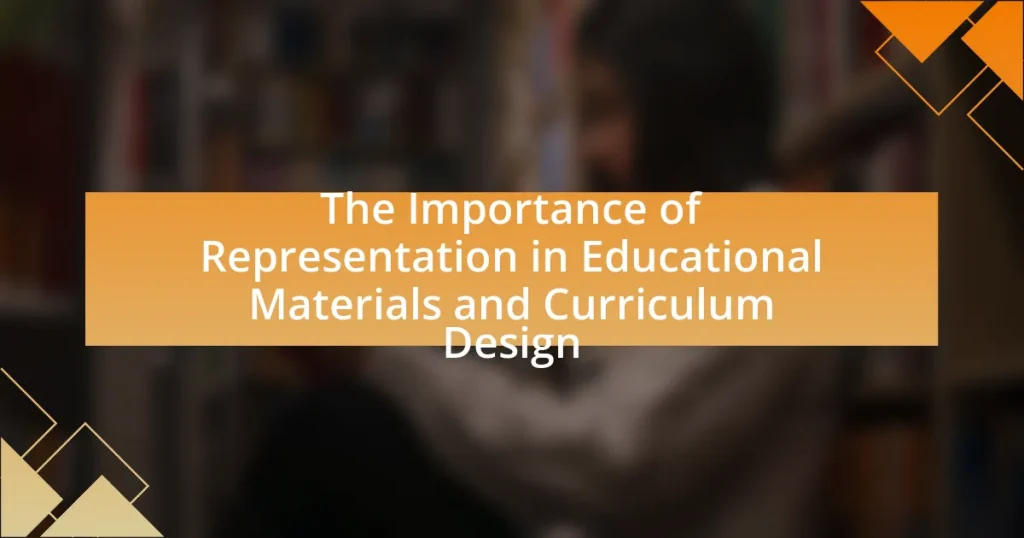Representation in educational materials and curriculum design is essential for fostering an inclusive learning environment that reflects diverse perspectives and experiences. This article explores the significance of representation, highlighting its impact on student engagement, academic performance, and self-esteem, particularly among marginalized groups. It examines the role of cultural relevance, key components of effective representation, and the challenges faced in achieving inclusivity in educational contexts. Additionally, the article discusses strategies for integrating diverse perspectives, the influence of technology, and the importance of policy changes in enhancing representation within education.

What is the Importance of Representation in Educational Materials and Curriculum Design?
Representation in educational materials and curriculum design is crucial because it ensures that diverse perspectives and experiences are included, fostering an inclusive learning environment. Inclusive representation helps students from various backgrounds see themselves in the curriculum, which can enhance engagement and motivation. Research indicates that when students encounter materials that reflect their identities, it positively impacts their academic performance and self-esteem. For instance, a study published in the “Journal of Educational Psychology” found that students who learned from culturally relevant materials demonstrated higher levels of academic achievement compared to those who did not. Thus, representation in educational resources is essential for promoting equity and improving educational outcomes.
Why is representation crucial in educational contexts?
Representation is crucial in educational contexts because it ensures that diverse perspectives and experiences are included, fostering an inclusive learning environment. When students see themselves reflected in the curriculum, it enhances their engagement and motivation, leading to improved academic outcomes. Research indicates that inclusive representation can reduce feelings of alienation and increase self-esteem among marginalized groups, as evidenced by a study published in the Journal of Educational Psychology, which found that students who encountered diverse role models in their learning materials performed better academically. Thus, representation not only validates students’ identities but also promotes equity and social justice within education.
How does representation impact student engagement and learning outcomes?
Representation significantly enhances student engagement and learning outcomes by fostering a sense of belonging and relevance among diverse learners. When students see themselves reflected in educational materials, they are more likely to connect with the content, which increases their motivation to participate actively in learning activities. Research indicates that inclusive representation can lead to improved academic performance; for instance, a study published in the Journal of Educational Psychology found that students who encountered diverse perspectives in their curriculum demonstrated higher levels of critical thinking and engagement compared to those who did not. This correlation underscores the importance of incorporating varied representations in educational settings to support all students effectively.
What role does cultural relevance play in educational materials?
Cultural relevance plays a crucial role in educational materials by ensuring that content reflects the diverse backgrounds and experiences of students, which enhances engagement and learning outcomes. When educational materials incorporate culturally relevant examples, narratives, and perspectives, they validate students’ identities and experiences, fostering a sense of belonging and motivation to learn. Research indicates that culturally relevant pedagogy can improve academic performance; for instance, a study by Ladson-Billings (1994) found that students who engaged with culturally relevant teaching methods demonstrated higher levels of academic achievement and critical thinking skills. This alignment between educational content and students’ cultural contexts not only promotes inclusivity but also prepares students to navigate a multicultural society effectively.
What are the key components of effective representation in curricula?
The key components of effective representation in curricula include inclusivity, diversity, relevance, and accessibility. Inclusivity ensures that all students see themselves reflected in the materials, fostering a sense of belonging. Diversity encompasses a wide range of perspectives, cultures, and experiences, which enriches the learning environment. Relevance connects the curriculum content to students’ lives and interests, enhancing engagement and motivation. Accessibility guarantees that all students, regardless of their abilities or backgrounds, can access and benefit from the curriculum. Research indicates that curricula incorporating these components lead to improved student outcomes and engagement, as evidenced by studies showing higher achievement levels among students exposed to diverse and inclusive educational materials.
How can diverse perspectives be integrated into educational content?
Diverse perspectives can be integrated into educational content by incorporating a variety of cultural, historical, and social viewpoints in curriculum design. This can be achieved through the inclusion of texts, resources, and examples that reflect the experiences and contributions of different groups, such as women, people of color, and LGBTQ+ individuals. Research indicates that when students encounter diverse perspectives, it enhances critical thinking and empathy, as shown in a study by the American Educational Research Association, which found that inclusive curricula improve student engagement and academic performance. Additionally, collaboration with community members and experts from various backgrounds can ensure that educational materials are representative and relevant, fostering a more inclusive learning environment.
What types of representation should be considered in curriculum design?
Curriculum design should consider three main types of representation: linguistic, visual, and embodied. Linguistic representation involves the use of language, including written and spoken words, to convey information and concepts. Visual representation encompasses images, diagrams, and other visual aids that enhance understanding and retention of material. Embodied representation refers to the use of physical activities or gestures to facilitate learning through movement and interaction. Research indicates that diverse representations cater to different learning styles and improve engagement, as supported by the Universal Design for Learning framework, which emphasizes multiple means of representation to accommodate varied learners.
How does representation influence equity in education?
Representation significantly influences equity in education by ensuring that diverse perspectives and experiences are included in educational materials and curriculum design. When students see themselves reflected in what they learn, it fosters a sense of belonging and validation, which can enhance their engagement and academic performance. Research indicates that inclusive curricula can lead to improved outcomes for marginalized groups; for instance, a study published in the Journal of Educational Psychology found that students from underrepresented backgrounds performed better academically when their cultural identities were acknowledged in the curriculum. This demonstrates that representation not only promotes equity but also contributes to a more effective learning environment for all students.
What disparities exist in current educational materials regarding representation?
Current educational materials exhibit significant disparities in representation, particularly concerning race, gender, and socioeconomic status. Research indicates that textbooks and curricula often prioritize Eurocentric perspectives, marginalizing contributions from diverse cultures and communities. For instance, a study by the National Council of Teachers of English found that less than 10% of literature anthologies include works by authors from underrepresented groups. Additionally, gender representation remains skewed, with male figures frequently dominating historical narratives and scientific achievements, as highlighted in a report by the Geena Davis Institute on Gender in Media, which noted that only 31% of characters in children’s media are female. These disparities can lead to a lack of relatability and engagement for students from diverse backgrounds, ultimately affecting their educational outcomes.
How can inclusive practices promote equity in learning environments?
Inclusive practices promote equity in learning environments by ensuring that all students, regardless of their backgrounds or abilities, have equal access to educational opportunities and resources. These practices involve adapting teaching methods, materials, and assessments to meet diverse needs, which helps to eliminate barriers to learning. For instance, research by the National Center for Learning Disabilities indicates that inclusive classrooms improve academic outcomes for students with disabilities, as they benefit from peer interactions and differentiated instruction. Furthermore, inclusive practices foster a sense of belonging and respect among students, which enhances engagement and motivation, ultimately leading to improved educational equity.
What challenges exist in achieving representation in educational materials?
Achieving representation in educational materials faces several challenges, including bias in content creation, lack of diverse authors, and insufficient funding for inclusive resources. Bias in content creation often leads to the underrepresentation of marginalized groups, as historical narratives and perspectives are predominantly shaped by those in power. The lack of diverse authors contributes to a narrow viewpoint, limiting the variety of experiences and cultures presented in educational materials. Furthermore, insufficient funding restricts the development and distribution of inclusive resources, making it difficult for educational institutions to adopt materials that reflect a broader spectrum of identities and experiences. These challenges hinder the goal of creating equitable and representative educational environments.
What barriers do educators face when implementing diverse curricula?
Educators face several barriers when implementing diverse curricula, including lack of resources, insufficient training, and resistance from stakeholders. Limited access to diverse teaching materials restricts educators’ ability to present varied perspectives, while inadequate professional development hampers their understanding of culturally responsive teaching methods. Additionally, some parents and community members may resist changes to the curriculum, fearing that it undermines traditional educational values. Research indicates that these barriers can significantly hinder the effectiveness of diverse curricula, as highlighted in a study by the National Education Association, which found that 70% of teachers reported feeling unprepared to teach diverse content due to these challenges.
How can institutions overcome resistance to change in curriculum design?
Institutions can overcome resistance to change in curriculum design by actively involving stakeholders in the decision-making process. Engaging faculty, students, and community members fosters a sense of ownership and reduces apprehension towards new initiatives. Research indicates that when stakeholders participate in curriculum development, the likelihood of acceptance increases significantly; for instance, a study by the American Educational Research Association found that collaborative approaches led to a 30% improvement in stakeholder buy-in for curriculum changes. Additionally, providing professional development and resources to educators can equip them with the necessary skills and confidence to implement new curricula effectively, further mitigating resistance.
How can educators and curriculum designers improve representation?
Educators and curriculum designers can improve representation by incorporating diverse perspectives and materials that reflect various cultures, identities, and experiences. This can be achieved by selecting texts, resources, and examples that include contributions from historically marginalized groups, ensuring that students see themselves and their communities represented in the curriculum. Research indicates that inclusive curricula enhance student engagement and academic performance, as evidenced by a study published in the Journal of Educational Psychology, which found that students exposed to diverse content demonstrated higher levels of critical thinking and empathy. By actively seeking out and integrating these diverse materials, educators can create a more equitable learning environment that fosters understanding and respect among all students.
What strategies can be employed to evaluate the representation in existing materials?
To evaluate the representation in existing materials, one effective strategy is to conduct a content analysis that systematically examines the presence and portrayal of diverse groups. This method involves identifying key themes, frequency of representation, and the context in which different groups are depicted. For instance, a study by the American Educational Research Association found that educational materials often underrepresent minority groups, highlighting the need for critical evaluation. Additionally, employing surveys or focus groups with diverse stakeholders can provide insights into perceptions of representation, ensuring that materials resonate with a broader audience. These strategies collectively enhance the understanding of representation in educational contexts.
How can collaboration with diverse communities enhance curriculum design?
Collaboration with diverse communities enhances curriculum design by integrating varied perspectives and cultural contexts, which leads to more inclusive and relevant educational materials. This approach ensures that the curriculum reflects the experiences and needs of all students, promoting engagement and understanding. Research indicates that inclusive curricula can improve student performance and foster a sense of belonging, as seen in studies like “The Impact of Culturally Relevant Pedagogy on Student Achievement” by Ladson-Billings, which highlights the positive effects of culturally responsive teaching on diverse learners. By involving diverse communities, educators can create a curriculum that not only acknowledges but also values different backgrounds, ultimately enriching the educational experience for all students.
What best practices can be adopted for inclusive curriculum development?
Best practices for inclusive curriculum development include integrating diverse perspectives, ensuring accessibility, and fostering collaboration among stakeholders. Integrating diverse perspectives involves incorporating materials and examples that reflect various cultures, identities, and experiences, which enhances relevance and engagement for all students. Ensuring accessibility means designing curriculum that accommodates different learning styles and needs, such as providing materials in multiple formats and using assistive technologies. Fostering collaboration among stakeholders, including educators, students, and community members, promotes a shared understanding of inclusivity and encourages the co-creation of curriculum that meets the needs of all learners. These practices are supported by research indicating that inclusive curricula improve student outcomes and foster a sense of belonging in educational settings.
How can feedback from students and communities shape educational materials?
Feedback from students and communities can significantly shape educational materials by ensuring that content is relevant, inclusive, and reflective of diverse perspectives. When students and community members provide input, they highlight specific cultural, social, and educational needs that may not be addressed in traditional curricula. For instance, research conducted by the National Education Association indicates that inclusive curricula improve student engagement and academic performance, as they resonate more with students’ backgrounds and experiences. This feedback loop allows educators to adapt materials to better serve all learners, fostering a more equitable educational environment.
What resources are available to support representation in education?
Resources available to support representation in education include diverse educational materials, training programs, and advocacy organizations. Diverse educational materials, such as books, videos, and online resources that reflect various cultures, identities, and experiences, help create an inclusive curriculum. Training programs for educators, like workshops on culturally responsive teaching, equip teachers with strategies to incorporate representation effectively. Advocacy organizations, such as the National Association for Multicultural Education, provide guidelines and resources to promote equity and representation in educational settings. These resources collectively enhance the representation of marginalized groups in education, fostering a more inclusive learning environment.
What are the future trends in representation within educational materials?
Future trends in representation within educational materials include increased diversity, the integration of technology, and a focus on inclusivity. Educational materials are evolving to reflect a broader range of cultural, racial, and gender identities, ensuring that all students see themselves represented. For instance, research by the National Council of Teachers of English highlights that diverse representation in texts enhances student engagement and learning outcomes. Additionally, the use of digital platforms allows for more interactive and personalized learning experiences, catering to various learning styles and backgrounds. This shift towards inclusivity and representation is supported by educational policies advocating for equitable access to resources, as seen in initiatives like the Every Student Succeeds Act, which emphasizes the importance of diverse curricula.
How is technology influencing representation in curriculum design?
Technology is influencing representation in curriculum design by enabling diverse perspectives and inclusive content through digital platforms. These platforms facilitate access to a wide range of resources, allowing educators to incorporate materials that reflect various cultures, identities, and experiences. For instance, the use of multimedia tools, such as videos and interactive simulations, can present historical events from multiple viewpoints, enhancing students’ understanding of complex social issues. Research indicates that inclusive curriculum design, supported by technology, leads to improved student engagement and academic performance, as it resonates more with a diverse student body.
What role will policy changes play in enhancing representation in education?
Policy changes will play a crucial role in enhancing representation in education by establishing frameworks that promote inclusivity and diversity in curricula. These changes can mandate the inclusion of diverse perspectives and materials that reflect the backgrounds and experiences of all students, thereby fostering a more equitable learning environment. For instance, research from the National Education Association indicates that inclusive curricula can improve student engagement and academic performance, particularly among underrepresented groups. By implementing policies that prioritize representation, educational institutions can ensure that all students see themselves reflected in their learning materials, which is essential for their identity development and academic success.
What practical steps can educators take to ensure representation in their teaching?
Educators can ensure representation in their teaching by incorporating diverse perspectives and materials that reflect various cultures, identities, and experiences. This can be achieved by selecting texts and resources that include authors and characters from underrepresented groups, thereby providing students with relatable and varied viewpoints. Research indicates that inclusive curricula enhance student engagement and academic performance, as seen in a study by the National Education Association, which found that students exposed to diverse content demonstrate improved critical thinking skills and cultural awareness. Additionally, educators should actively seek professional development opportunities focused on diversity and inclusion to better understand how to implement these practices effectively.



